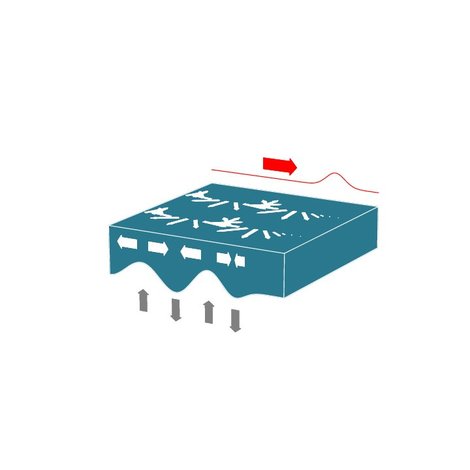Page path:
- ArcTrain
- HB-1-6
HB-1-6
Internal Wave Field - Energy Flux Considerations
| PhD student : | Georg Sebastian Voelker |
| Project supervisors : | M. Walter, M. Rhein (Germany) |
| P. Myers, B. Ruddick (Canada) |
Key hypothesis
Wind is one of the two major forcing mechanisms of internal waves. Strong and variable winds in the subarctic North Atlantic lead to high variability and elevated energy density in the internal wave field and subsequent mixing compared to mid and low latitudes.
Wind is one of the two major forcing mechanisms of internal waves. Strong and variable winds in the subarctic North Atlantic lead to high variability and elevated energy density in the internal wave field and subsequent mixing compared to mid and low latitudes.
Project Description
Internal waves (IW) are a crucial carrier of energy in the ocean interior. The two main sources for IW excitation are the interaction of tidal motion with the bathymetry and the generation by winds. In contrast to the steady generation of internal tides the excitation of IWs by winds is subject to it's variability and regional differences in weather conditions. Thus, the importance of wind generated IWs in the subpolar and mid latitude regions is potentially higher than in low latitudes.
Internal waves (IW) are a crucial carrier of energy in the ocean interior. The two main sources for IW excitation are the interaction of tidal motion with the bathymetry and the generation by winds. In contrast to the steady generation of internal tides the excitation of IWs by winds is subject to it's variability and regional differences in weather conditions. Thus, the importance of wind generated IWs in the subpolar and mid latitude regions is potentially higher than in low latitudes.
This project aims to investigate the behaviour of the IW energetics in the North Atlantic. Dominant energy sources and sinks shall be identified and quantified. Both, spatial patterns including hot spots and temporal patterns like seasonal cycles of the transfer mechanism will be analysed.
First, the energetics of wind generated IWs are analysed. A slab model using hourly wind forcing from the NCEP-CFSR reanalysis allowing computations up to high latitudes without loss of resonance was set up. It was validated with buoy data from 44 sites in the world ocean. Augmenting the one-dimensional model by the horizontal divergence of the near-inertial current field at the mixed layer base led to direct estimates of energy transfer spectra of radiation of internal waves into the ocean interior. The schematic at the side visualises this 'near inertial pumping' mechanism.
After quantifying the wind forcing, the next steps will be considerations of IWs generated by ocean currents at the bottom topography as well as interactions with the western boundary currents.
First, the energetics of wind generated IWs are analysed. A slab model using hourly wind forcing from the NCEP-CFSR reanalysis allowing computations up to high latitudes without loss of resonance was set up. It was validated with buoy data from 44 sites in the world ocean. Augmenting the one-dimensional model by the horizontal divergence of the near-inertial current field at the mixed layer base led to direct estimates of energy transfer spectra of radiation of internal waves into the ocean interior. The schematic at the side visualises this 'near inertial pumping' mechanism.
After quantifying the wind forcing, the next steps will be considerations of IWs generated by ocean currents at the bottom topography as well as interactions with the western boundary currents.

Schematic of 'near inertial pumping' introduced by Gill (1984). Near inertial motion is excited by a moving wind stress front on the surface. Subsequently the rotation of the near inertial motion and the corresponding phase shift lead to vertical movement at the base of the mixed layer.


